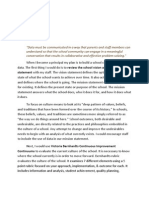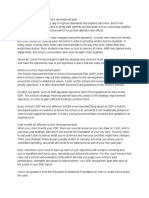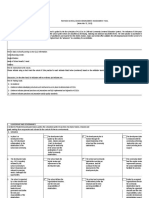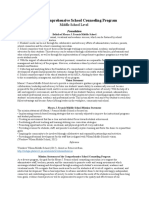0 ratings0% found this document useful (0 votes)
135 viewsMeasure
Measure
Uploaded by
api-257656254Copyright:
© All Rights Reserved
Available Formats
Download as PDF, TXT or read online from Scribd
Measure
Measure
Uploaded by
api-2576562540 ratings0% found this document useful (0 votes)
135 views6 pagesOriginal Title
measure
Copyright
© © All Rights Reserved
Available Formats
PDF, TXT or read online from Scribd
Share this document
Did you find this document useful?
Is this content inappropriate?
Copyright:
© All Rights Reserved
Available Formats
Download as PDF, TXT or read online from Scribd
Download as pdf or txt
0 ratings0% found this document useful (0 votes)
135 views6 pagesMeasure
Measure
Uploaded by
api-257656254Copyright:
© All Rights Reserved
Available Formats
Download as PDF, TXT or read online from Scribd
Download as pdf or txt
You are on page 1of 6
MEASURE Accountability Process for School Counselors
Name and Address of School:
Name of Counselor(s) Leading the Initiative:
Principal:
Enrollment:
School Demographics:
Caucasian/Non-Hispanic: African American:
Hispanic: Asian: Other:
Free-Reduced Lunch:
ESL:
Step One: Mission statements
District goals/mission/vision statement:
Campus Mission/Goal:
example: We, the staff, students, and parents, commit to a well-balanced education. Learning experiences will
promote mental, emotional, social, and physical growth as well as aesthetic and cultural awareness.
Program mission statement: (Connect your work to your schools mission).
example: It is the counseling departments belief that all students can nd academic success on their
own terms. Our role is to facilitate that success through the implementation of a comprehensive
guidance program to remove as many barriers as possible to students academic success.
Discussion with campus principal: (AYP needs). What was the outcome?
example: bullying, test scores, graduation rates, parent involvement...
Perry High School, 2770 E. Breese Rd., Lima, OH, 45806
Jordane Duffy
Nick Weingart
382 (7-12)
63.4% (242)
24.2% (92)
N/A (fewer than 10)
N/A
Multiracial: 11.1% (42)
60% (232 out of 382)
N/A
The growing emphasis on educational standards, equity, continuous improvement, and accountability, is fueled by widespread recognition that schools must become high-performing organizations if they
are to prepare all students to succeed in the twenty-first century. Today, our students represent an unprecedented level of diversity - in abilities, learning styles, prior educational experience, attitudes and
habits related to learning, language, culture, and home situations. The challenge of educating these students requires a commitment to base decisions on sound information and effectively use many
types of data from multiple source to realizing a vision of high school education that embraces the belief of high expectations for all students.
Our students will perform at a level that surpasses or is equal to their ability in all areas of
achievement. We will promote high expectations for students in all areas: academic, artistic, physical, health, citizenship and service. In a fiscally
responsible manner, we will commit the resources necessary to establish and maintain: a respectful, caring, and safe environment; research-based,
student-focused instruction; information-driven decision making; a focused and challenging curriculum; collaboration focused on improving student
learning; and an active partnership with parents and community.
N/A
'13-'14 --> 268 out of school suspension (7-12)
--> 274 in school suspension (7-12)
Step Two: Data What current hard data are you going to impact?
Example: Grades, Test Scores, Attendance, School Completion, Promotion, Post Secondary
Going, Academic Rigor, Academic Relevance...
The school counselor as part of the leadership team identied these critical data elements to try to
impact:
Step Three: Analyze Analyze the data to see what it reveals, to identify the problem
areas, to establish your baseline and to set your goal. It may be necessary to disaggregate the data,
e.g. race, ethnicity, gender, ESL, teacher assignment.
Baseline: (Where is the data element currently?)
Where do you want the data element to be in a year?
Step Four: Stakeholders-Unite
Develop an Action Plan School Counselors, as managers of resources, join existing groups of
stakeholders, such as the school improvement team, or bring other stakeholders and resources into
the task of creating and implementing an action plan. Strategies are developed that will change
systems as well as impact individual students and targeted groups of students.
Impacting systems means (1) replicating successful programs and interventions; (2) identifying
barriers that adversely stratify students opportunities to be successful learners; and (3)
developing strategies to:
. strengthen curriculum offerings
. maximize the instructional program
. enhance the school and classroom culture and climate
. provide student academic support systems (safety nets)
. inuence course enrollment patterns to widen access to rigorous academics
. involve parents and other critical stakeholders (internal and external to the school)
. raise aspirations in students, parents, teachers, the community
. change attitudes and beliefs about students and their abilities to learn
Beginning date:
Ending date:
decrease out of school suspensions
Stakeholders Strategies
Student and Social
Services Personnel
School Counselors
Behavior
Interventionist
LSSP
Teachers
Administrators
Students
Technology
Community Agency
Members
Local Colleges
Grants
Parents
Step Five: Reanalyze, Reect, and Revise
Reect and Revise:
Reanalyze: Reect on why the stakeholders were successful after the action plan? Did the
strategies work?
Restate the baseline data. Where is the data? Have you been successful or unsuccessful? Revise
the action plan if needed so that you have a positive impact on the data so progress can be made
and you can continue to get better results. Restate the baseline data: Which of the strategies
worked? Data after action plan: Which strategies should be replaced? Added?
Impact: Based on what you have learned, how will you revise the action plan?
Systemic Changes Made:
Whenever you implement a MEASURE you will contribute to systemic change. Each MEASURE
will in some way change a school, home, or community system to enhance student learning.
Capture these systemic changes here and record them on your report card.
Step Six: Educate
Promote and publicize the results of your work. Develop a report card for your own program to let
the internal and external school members know your work is connected to Vision 2010, the
mission of the school and to student success. The School Counseling Program Accountability
Our MEASURE of Success
SPARC - School Counseling Program Accountability Report Card
School & enrollment:
Principal:
Counselor:
Principal comments:
Base line data & End Data:
Interventions completed:
School Improvement Issues:
Systemic Changes:
Stakeholders Roles:
You might also like
- Public Value and Art For All?Document20 pagesPublic Value and Art For All?yolandaniguasNo ratings yet
- Sustaining ImprovementDocument6 pagesSustaining Improvementapi-520679261100% (1)
- Difference Between Policy and StrategyDocument4 pagesDifference Between Policy and StrategyAbu Taleb83% (6)
- Buffalo Public Schools 2013-18 Strategic PlanDocument54 pagesBuffalo Public Schools 2013-18 Strategic PlanSandra TanNo ratings yet
- Measure Assignment WilliamsDocument5 pagesMeasure Assignment Williamsapi-256935407No ratings yet
- CHAPTER 1 - The Meaning and Importance of TourismDocument46 pagesCHAPTER 1 - The Meaning and Importance of Tourismapple77% (13)
- Measure - ElmwoodDocument5 pagesMeasure - Elmwoodapi-257829203No ratings yet
- Schlumpf Data Culture PlanDocument4 pagesSchlumpf Data Culture PlanGlenn E. Malone, Ed.D.No ratings yet
- Measure MonceauxDocument6 pagesMeasure Monceauxapi-289274727No ratings yet
- School Improvement Plan JW Parker Middle SchoolDocument24 pagesSchool Improvement Plan JW Parker Middle SchoolKrista FasoliNo ratings yet
- Standard 1: Vision and PurposeDocument6 pagesStandard 1: Vision and Purposehenderson_brianNo ratings yet
- Comprehensive Program PowerPointDocument10 pagesComprehensive Program PowerPointJaraed ThomasNo ratings yet
- Ocs Communication PlanDocument22 pagesOcs Communication Planapi-280798009No ratings yet
- Roadmap To ExcellenceDocument29 pagesRoadmap To ExcellenceKumen22No ratings yet
- The Importance of Data-Based Decision Making: VignetteDocument11 pagesThe Importance of Data-Based Decision Making: VignetteJoviner Yabres LactamNo ratings yet
- Strategic Planning Process-6Document17 pagesStrategic Planning Process-6mosam123No ratings yet
- The Five Attributes of Successful SchoolsDocument13 pagesThe Five Attributes of Successful SchoolsJanet AlmenanaNo ratings yet
- Revised Assessment Tool SBMDocument12 pagesRevised Assessment Tool SBMRoel Tanola83% (6)
- Title: Academic ProgramDocument6 pagesTitle: Academic ProgramRazel Daniel RoblesNo ratings yet
- Daycare Strategic PlanDocument37 pagesDaycare Strategic Planمهندسةزينب جعفرNo ratings yet
- Brianna Ball & Hailey Kreinbrink Mission StatementDocument26 pagesBrianna Ball & Hailey Kreinbrink Mission Statementapi-534372341No ratings yet
- Alexandra Penn's ApplicationDocument19 pagesAlexandra Penn's ApplicationThe Florida Times-UnionNo ratings yet
- Evaluation Plan - Assignment 4Document3 pagesEvaluation Plan - Assignment 4lm03229No ratings yet
- OpenDoorsCSIP 23Document8 pagesOpenDoorsCSIP 23rashid.m.dzamboNo ratings yet
- Act. 3, Tolentino, Marjorie R.Document4 pagesAct. 3, Tolentino, Marjorie R.Tolentino, Marjorie ReginaldoNo ratings yet
- Best Practices in Strategic Planning, Organizational Development, and School EffectivenessDocument33 pagesBest Practices in Strategic Planning, Organizational Development, and School EffectivenesskeziaNo ratings yet
- Broad AssessmentDocument6 pagesBroad AssessmentJulian A.No ratings yet
- SDPDocument5 pagesSDPCristineNo ratings yet
- Is It Working in Your Middle School?: A Personalized System to Monitor Progress of InitiativesFrom EverandIs It Working in Your Middle School?: A Personalized System to Monitor Progress of InitiativesNo ratings yet
- Latanya Greer, M.Ed., J.D.: Professional SummaryDocument2 pagesLatanya Greer, M.Ed., J.D.: Professional Summaryapi-292742648No ratings yet
- Exemplar 1Document4 pagesExemplar 1api-315905890No ratings yet
- Sip 2014-2016Document19 pagesSip 2014-2016api-271885581No ratings yet
- Module 56 Production of Social Studies Instructional MaterialsDocument20 pagesModule 56 Production of Social Studies Instructional MaterialsJessa Mae RoneNo ratings yet
- Revised Assessment Tool SBMDocument20 pagesRevised Assessment Tool SBMRichard Alboro50% (2)
- WK 7 ProjedingeraDocument9 pagesWK 7 Projedingeraapi-270741806No ratings yet
- Delivery PieceDocument3 pagesDelivery Pieceapi-300688730No ratings yet
- MET - Feedback For Better Teaching - Principles PaperDocument12 pagesMET - Feedback For Better Teaching - Principles PaperBudulan RaduNo ratings yet
- CounselingcoverDocument2 pagesCounselingcoverapi-257374427No ratings yet
- Response To Intervention: New Roles For School Social WorkersDocument4 pagesResponse To Intervention: New Roles For School Social WorkersYashaswini YashuNo ratings yet
- Thesis On School Improvement PlanDocument8 pagesThesis On School Improvement Plankatemillerportland100% (2)
- Best Practice Stop 50 SitesDocument7 pagesBest Practice Stop 50 Sitespaolo furioNo ratings yet
- Standard 7Document6 pagesStandard 7api-335128593No ratings yet
- Winter 16 SipreviewtemplateDocument3 pagesWinter 16 Sipreviewtemplateapi-324577171No ratings yet
- Working Together To Inspire Learning and Achievement in Highland CommunitiesDocument8 pagesWorking Together To Inspire Learning and Achievement in Highland Communitiesapi-2039133130% (1)
- Class 5 Sample Supervision PlanDocument6 pagesClass 5 Sample Supervision PlanEbb Lian AninoNo ratings yet
- Health - Cat Enloehs Wcpss Net Sip Plan 2010 2012 PDFDocument21 pagesHealth - Cat Enloehs Wcpss Net Sip Plan 2010 2012 PDFpterodaktilNo ratings yet
- Sample Comprehensive School Counseling ProgramDocument39 pagesSample Comprehensive School Counseling ProgramLaura Witt75% (4)
- Marsh Isllc Self-Assessment ToolDocument17 pagesMarsh Isllc Self-Assessment Toolapi-240190507No ratings yet
- Smoking Out Underachievement: Guidance and Advice To Help Secondary Schools Use Value Added Approaches With DataDocument75 pagesSmoking Out Underachievement: Guidance and Advice To Help Secondary Schools Use Value Added Approaches With DataJHNo ratings yet
- Artifact 6-8Document31 pagesArtifact 6-8api-419010396No ratings yet
- IHEP Final VersionDocument58 pagesIHEP Final VersionFrankChiNo ratings yet
- Standard Five - Program EvaluationDocument16 pagesStandard Five - Program Evaluationapi-737263335No ratings yet
- Academic Enhancement Tools: Power in Family Relationships Builds Student Academic Success, Parent ManualFrom EverandAcademic Enhancement Tools: Power in Family Relationships Builds Student Academic Success, Parent ManualNo ratings yet
- Data Board InquiryDocument16 pagesData Board InquirylynjonesNo ratings yet
- Workshop04a ReachingeverychildDocument2 pagesWorkshop04a Reachingeverychildapi-311382601No ratings yet
- Assessment Policy Revised 6 27 12Document5 pagesAssessment Policy Revised 6 27 12api-147600993No ratings yet
- Driving Toward Greater Postsecondary Attainment Using Data (Complete PDFDocument58 pagesDriving Toward Greater Postsecondary Attainment Using Data (Complete PDFInstitute for Higher Education Policy100% (1)
- Assessment of Learning MidtermDocument6 pagesAssessment of Learning MidtermRyan LaspiñasNo ratings yet
- Fbla Pbis Marshall-ReepingDocument10 pagesFbla Pbis Marshall-Reepingapi-319740475No ratings yet
- 29 Ascas National ModelDocument59 pages29 Ascas National Modelapi-290807133No ratings yet
- CLC 523 PlcsDocument17 pagesCLC 523 Plcsapi-475628631100% (3)
- Empowering Students For Success: Family Relationships are the Basis of the Student's SuccessFrom EverandEmpowering Students For Success: Family Relationships are the Basis of the Student's SuccessNo ratings yet
- 1415 High School Kim 120814Document45 pages1415 High School Kim 120814api-257656254No ratings yet
- SparcDocument1 pageSparcapi-257656254No ratings yet
- Ohva Group-FinalDocument17 pagesOhva Group-Finalapi-257656254No ratings yet
- Resume March 2015Document2 pagesResume March 2015api-257656254No ratings yet
- Cleanest Classroom: Tagaytay City Intergrated SchoolDocument2 pagesCleanest Classroom: Tagaytay City Intergrated SchoolAngel MartinNo ratings yet
- 8 - M (Physical) 8 - M: Period PeriodDocument1 page8 - M (Physical) 8 - M: Period Periodhafsa khalidNo ratings yet
- Fluency TR F J Bye BuddyDocument2 pagesFluency TR F J Bye Buddyapi-474499331No ratings yet
- Introduction To Debt PolicyDocument8 pagesIntroduction To Debt PolicyRatnesh DubeyNo ratings yet
- Removal of DirectorsDocument3 pagesRemoval of DirectorsD.Satya Siva DarshanNo ratings yet
- PROG-111 Week 1-9Document89 pagesPROG-111 Week 1-9Jaspher0% (1)
- 9004143831Document307 pages9004143831intcomlaw100% (1)
- Week 11 Powerpoint SLP Forensic ChemistryDocument52 pagesWeek 11 Powerpoint SLP Forensic ChemistrySheena De Guzman MorenoNo ratings yet
- Unit 1 An Overview of Ethics, Ethics For IT Workers and IT UsersDocument34 pagesUnit 1 An Overview of Ethics, Ethics For IT Workers and IT UsersPiyush KoiralaNo ratings yet
- Bse Eng B2021 LettersDocument10 pagesBse Eng B2021 LettersClaudine RosalesNo ratings yet
- REC 11 - Application For ExemptionDocument10 pagesREC 11 - Application For ExemptionMuhammad Farhan HanifNo ratings yet
- Senior Assistant 5th Level AdministrationDocument9 pagesSenior Assistant 5th Level AdministrationArjun kumar ShresthaNo ratings yet
- Sale of Immovable PropertyDocument13 pagesSale of Immovable Propertyshireen majumdarNo ratings yet
- Migne. Theologiae Cursus Completus. 1838. Volume 9.Document609 pagesMigne. Theologiae Cursus Completus. 1838. Volume 9.Patrologia Latina, Graeca et OrientalisNo ratings yet
- Case Study and Ethical Reasoning EssayDocument8 pagesCase Study and Ethical Reasoning Essayapi-271087867No ratings yet
- Photoshop Scripting GuideDocument91 pagesPhotoshop Scripting GuideRinoCalifanoNo ratings yet
- Lesson 2 Organization and Managment of SportsDocument8 pagesLesson 2 Organization and Managment of SportsCedrick Mesa Sali-otNo ratings yet
- What's CBMDocument2 pagesWhat's CBMWingNo ratings yet
- One Secret Side Effect of Walking Faster ArticleDocument2 pagesOne Secret Side Effect of Walking Faster ArticleANIK SAHANo ratings yet
- Central Finance OverviewDocument12 pagesCentral Finance OverviewV S Krishna AchantaNo ratings yet
- Learning Objectives:: Case 6. Epidemic AsthmaDocument13 pagesLearning Objectives:: Case 6. Epidemic AsthmaGaluh Ajeng PangestikaNo ratings yet
- ASTM C1609 - C1609M - 19a Standard Test Method For Flexural Performance of Fiber-Reinforced Concrete (Using Beam With Third-Point Loading)Document5 pagesASTM C1609 - C1609M - 19a Standard Test Method For Flexural Performance of Fiber-Reinforced Concrete (Using Beam With Third-Point Loading)ming_zhu10No ratings yet
- AadyaDocument20 pagesAadyanirshan rajNo ratings yet
- Engineering Economics: Various Concepts Used in Economic AnalysisDocument6 pagesEngineering Economics: Various Concepts Used in Economic AnalysisJai ChaudhryNo ratings yet
- Medha Patkar NYCposterDocument1 pageMedha Patkar NYCposterdrstrangelurveNo ratings yet
- ECE342 Course NotesDocument165 pagesECE342 Course NotesJordan ChipchuraNo ratings yet
- Discrete Probability Distributions: Mcgraw-Hill/IrwinDocument15 pagesDiscrete Probability Distributions: Mcgraw-Hill/IrwinImam AwaluddinNo ratings yet





























































































